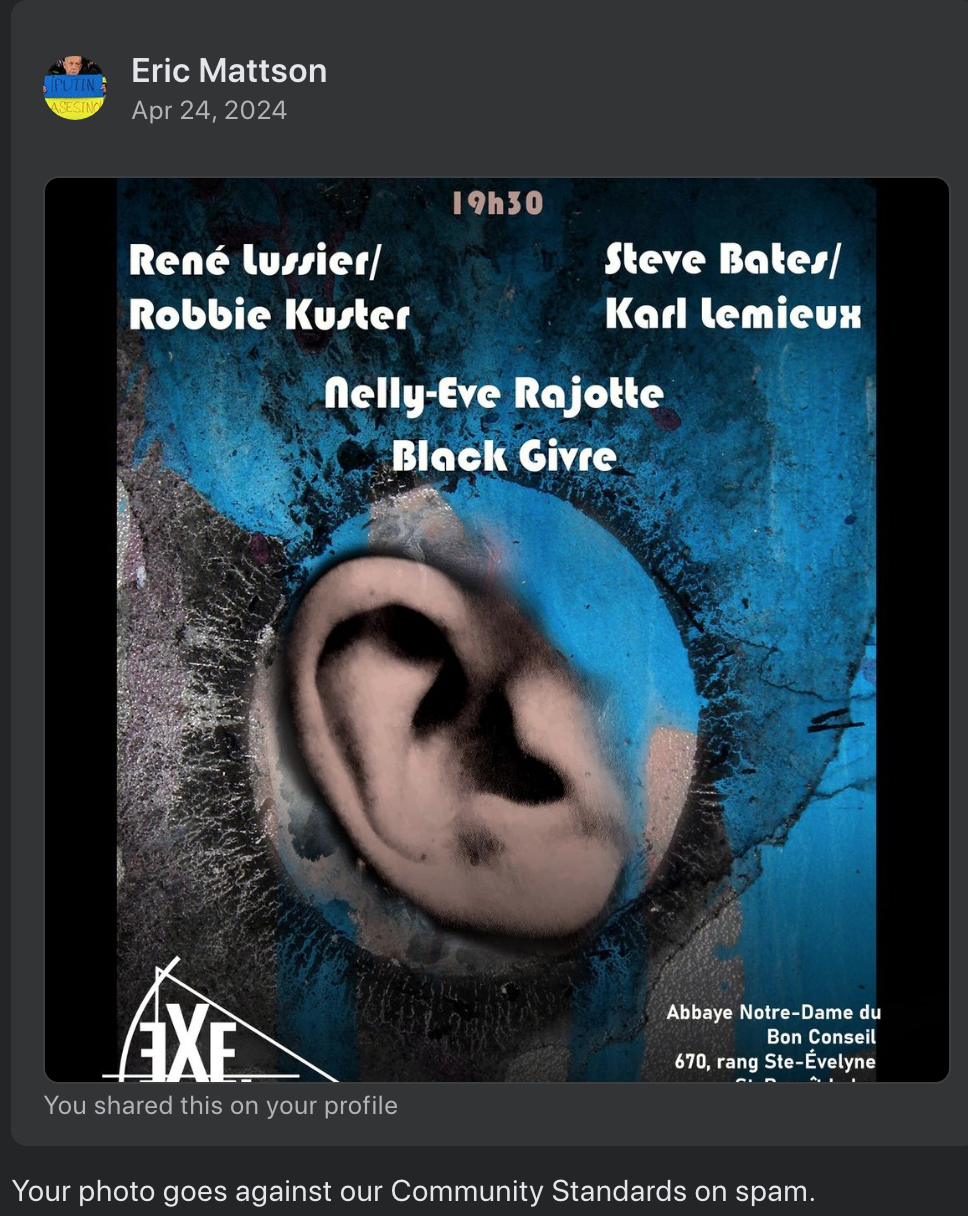René Lussier & Robbie Kuster
Steve Bates & Karl Lemieux
Nelly-Eve Rajotte
Black Givre
+
Delphy Boudreau
EXCENTRER présente Art sonore à l’abbaye 2024
27 avril – 27 avril
7 h 30 p.m. – 10 h 00 p.m. HAE
670 Rang Ste Éveline, Saint-Benoît Labre, QC G0M 1P0, Canada
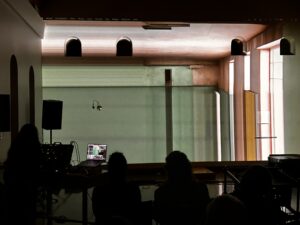
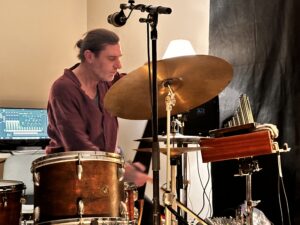
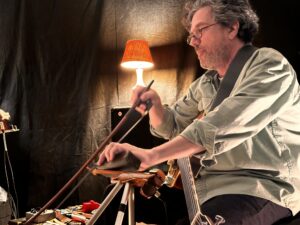
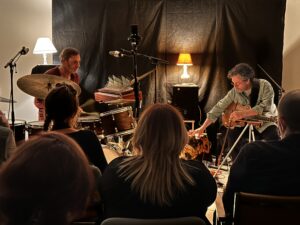
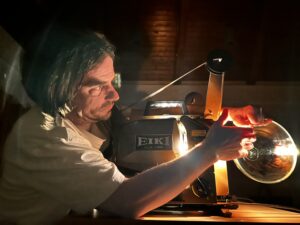
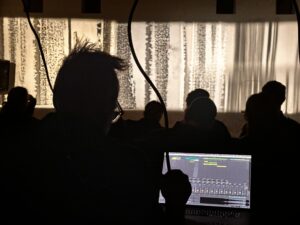
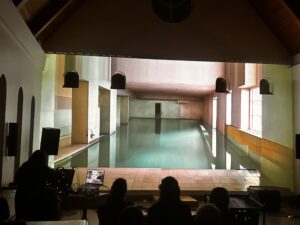
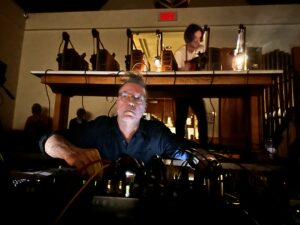
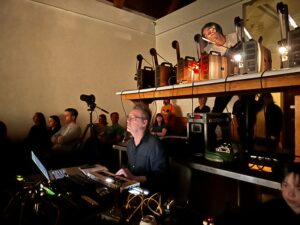
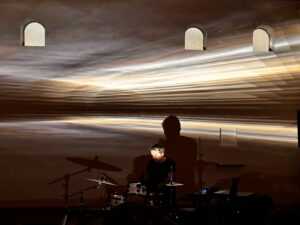
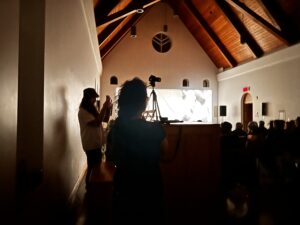
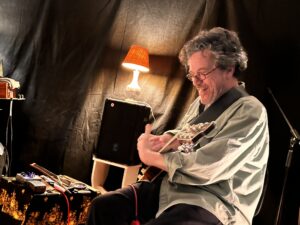
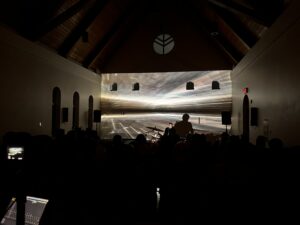

Karl
Karl Lemieux is a filmmaker, who’s work is inspired by the dialogue that occurs between film, music and sound art. At the heart of his practice, also including narrative filmmaking, the importance of the cinematographic apparatus and the attachment to celluloid are essential. His films, installations, and performances have screened internationally in museums, galleries, music venues and film festivals including: the Montreal Contemporary Arts Museum, the MOMA — Museum of Modern Art in San Francisco, the Austrian Film Museum in Vienna and the Eye Filmmuseum in Amsterdam. He is known for is collaboration with Godspeed You! Black Emperor, a Montreal music collective for which he does live 16mm film projections since 2010. He is also the co-founder of Double Négatif, a Montreal-based collective, dedicated to the production and dissemination of experimental films. His first feature, Maudite Poutine (Shambles), premiered in the Orizzonti competition of the 73rd Venice International Film Festival organized by the Venice Biennale.
Cinéaste expérimental montréalais, originaire de Kingsey-Falls, près de Victoriaville, Karl Lemieux a grandi avec le Festival international de musique actuelle et, très tôt, il a souhaité donner un équivalent visuel à ces musiques. Il a étudié le cinéma à l’Université Concordia, et dès son premier court métrage, il s’est intéressé au rapport entre l’image et le son. Avec Daichi Saito, il a fondé le collectif Double négatif voué à la production et à la diffusion du cinéma expérimental, et il a participé régulièrement à des concerts et performances de projection et altération en direct de films 16 mm manipulés sur deux à sept projecteurs à la fois — on se souvient ici de sa participation à la Nocturne du 4 avril 2008 avec Pas Chic Chic.
An electric presence on Montreal’s emergent experimental film scene, Karl Lemieux has been composing artistically adventurous time-based media since the late-90s. His first project, a video interpretation of Lee Ranaldo’s talking sound-piece “The Bridge” (1985), made while attending high school in the Nevada desert, foreshadows Lemieux’s recent projector performances with live musicians. Deeply influenced by Québécois animator Pierre Hébert’s interdisciplinary film practice and mirroring his artistic trajectory, Lemieux explored hand-painting in Motion of Light (2004) before embracing the more aleatory possibilities of expanded cinema.
In 2006, Lemieux began an ongoing series of performances with the musician Radwan Moumneh (Jerusalem In My Heart) that brought Lemieux’s cameraless filmmaking techniques into the live arena. Orchestrating an assortment of hand-processed 16mm film loops through a suite of aged Eikis, Lemieux bleaches and paints filmstrips seconds before they hit the gate. Visually manifesting the intensity of Moumneh’s dense, chamber-style guitar, the violently handled and ruined film loops come close to the point of cathartic self-destruction. Lemieux has also collaborated with members of Godspeed You! Black Emperor, A Silver Mt. Zion, Shalabi Effect, Arcade Fire, and Set Fire to Flames, the spoken word artist and poet Alexis O’Hara, and the artist-musicians Alexandre St. Onge and Jonathan Parant.
In addition to his filmmaking initiatives and collaborations, Lemieux is also the co-founder of Double Negative, a collective of Montreal film and video artists dedicated to the production and exhibition of experimental film. Double Negative’s rising community presence, coupled with their advocacy of cinema’s wondrous, transformative potential, has provided Montreal’s independent projection locales with a bolt of positive energy, helping to solidify a ground for future activity.
I interviewed Lemieux at his home in Montreal’s Plateau district in summer 2007. Later we moved up to the Double Negative studio in Mile End, where the collective’s other founding member, Daïchi Saïto joined us.
Steve
Steve Bates est un artiste et musicien vivant actuellement à Saskatoon en Saskatchewan. Des expériences formatrices dans le milieu DIY punk (y compris avec un groupe local qui a joué en premiere partie de Fugazi, pour son premier concert), combinées à un diplôme en conception théâtrale et en philosophie, ont une grande influence sur son développement. Durant les années 80 et 90, Bates a joué dans des groupes de rock hardcore et indépendant (XOXO, Pull My Daisy, Bulletproof Nothing) tout en continuant à manipuler de manière obsessionnelle la radio à ondes courtes que son père lui avait offerte quand il était enfant – ces sensibilités continuent d’informer son travail sonore à ce jour.
Bates a fondé le festival Send + Receive en 1998; ce dernier a joué un role crucial crucial dans le positionnement de Winnipeg sur la carte de la musique d’avant-garde et de l’art sonore expérimental. Déménageant à Montréal en 2005, il a occupé le poste de coordinateur du son à Hexagram (Université Concordia), a sorti des œuvres en solo et en duo sur ORAL_records et deux albums avec Black Seas Ensemble sur son label The Dim Coast, tout en poursuivant une myriade d’autres projets de recherche, d’installation et de collaboration audio.
Bates explore un large éventail de thèmes dans ses projets d’installation musicaux et audiovisuels. Cherchant constamment à encourager et à provoquer une écoute active, Bates crée des mondes musicaux et sonores qui interrogent l’auditeur, tout en restant conscient de son libre arbitre et de son désir. Il travaille sur le terrain, à la radio, dans des contextes de muséologie/galerie et de performance, ces territoires mouvants étant cruciaux pour la texture et le contenu global de sa pratique. Ses expositions et ses œuvres in situ ont été présentées en Amérique du Nord et en Europe, au Chili et au Sénégal.
Bates continue également de jouer dans des groupes et de produire des disques, les publiant parfois sur son propre label The Dim Coast, notamment son projet à grande échelle Black Seas Ensemble. Il a réalisé des disques en duo sous le nom de Lanterner (avec l’artiste sonore et batteur Marc-Alexandre Reinhardt), Fifths (avec Elizabeth Anka Vajagic), ainsi qu’avec Sophie Trudeau (Godspeed You! Black Emperor) et Burkhard Stangl, pour n’en nommer que quelques-uns.
Après 15 ans à Montréal, Bates a déménagé à Saskatoon à la fin de 2019 – un retour dans les Prairies Canadiennes juste avant la pandémie et une dislocation/déménagement qui a profondément façonné sa pratique solitaire et immersive, qui par la suite a donné lieu à All The Things That Happen (Constellation, 2022), son œuvre la plus puissante à ce jour.
Black Givre
Black Givre est un projet solo créé à Montréal en 2012 par Samuel Bobony, un artiste sonore, musicien et compositeur dont les recherches portent sur la cohabitation d’univers hétérogènes, composés de paysages sonores, de sons concrets et de synthèse, combinés à sa batterie augmentée. Les processus graduels et de répétition ainsi que l’intensité physique caractérisent ses performances. Ses pièces explosives combinent batterie, textures sonores échantillonnées et synthétiseurs.
Il a réalisé plusieurs albums, performés devant public lors de festivals et de tournées nationales et internationales, dont Errance et mépris (La Cohu, 2018). Son nouvel album Imaginaire Drumscape sera publié chez Jeunesse Cosmique en 2024.
Samuel participe activement à la scène musicale montréalaise depuis quinze ans. Il a pris part à une vingtaine de formations musicales, dont Avec le Soleil Sortant de sa Bouche (Constellation Records), Pangea De Futura (ensemble de huit musicien.es, dont Eric Quach, Aiden Girt et Eric Craven), Actors Artificial (Jonathan Parant, Roger Tellier-Craig et Dominic Jasmin), LENTEMENT (Jerry Lee Boucher & Jessica Pion) et Red Mass. Récemment, il s’est joint au groupe Fly Pan Am (Constellation Records) à titre de batteur. Il a régulièrement performé dans le cadre de tournées présentées notamment au Canada, aux États-Unis, en France, en Allemagne, en Pologne, au Danemark et en Norvège.
De plus, il a collaboré à des projets pluridisciplinaires (audiovisuel, danse, théâtre, lutherie audionumérique et installation sonore) avec notamment: le metteur en scène Jocelyn Pelletier, la chorégraphe Dana Gingras et les artistes Myriam Boucher, Dominic Thibault, Guillaume Vallée, Nelly-Ève Rajotte et Sonya Stefan.
Enfin, Samuel conçoit des ateliers de médiation culturelle en arts sonores et siège actuellement au conseil d’administration du Centre Turbine, un organisme qui réalise des projets qui introduisent les arts actuels au sein de communautés diversifiées.
Nelly Eve
Nelly-Ève Rajotte is a professor at the School of Design of UQAM, where she heads the Moving Image and Sound Design axis. As a visual and media artist, her hybrid practice is particularly interested in moving image, sound, and immersion, through performance and installation. She is also a filmmaker, editor, and composer.
She holds a Master’s degree from the School of Visual and Media Arts at UQÀM, as well as studies in art history. In 2017, she was the President of the Jury (Digital Creation) for the Jeux de la Francophonie (Abidjan, Cote d’Ivoire). She has also been a guest professor and artist in residence at the Mel Hoppenheim School of Cinema at Concordia University in Montreal (2018-2020).
In addition to numerous exhibitions in Quebec, including at the Fonderie Darling, Parisian Laundry, Occurrence, Clark, Optica, and Circa, her works have been shown in several festivals in Canada, including MUTEK, the International Festival of Films on Art, the Mois Multi, and Espace [IM] Média, as well as internationally – International Short Film Festival of Berlin (Germany), Official Selection Transmediale (Germany), MUTEK (Argentina, Japan, and Mexico), Lab30 (Germany), Moscow International Film Festival, EXiS (Korea), Finnish Contemporary Art Fair (Finland), and ISEA2020. Her work is part of the Hydro-Québec Collection.
Using video and sound as her primary mediums, Nelly-Ève Rajotte operates at the confluence of performance, image, and installation. Recognized among other things for her monumental projections, Rajotte is interested in the sensitive conditions of the spectator experience. She explores the relationship to space and delves into the branching of physical sensations and psychological states inscribed in reception. Her combined work of image and sound reflects a certain alterity of representation and experience.
Around the recurring figure of the landscape, Rajotte adopts a romantic posture where tensions and oppositional plays of composition allow for the exploration of image construction processes. She borrows from cinematic strategies of editing and staging that not only transform but also aestheticize reality. Streamlined and fragile, the landscape thus asserts itself through the artist’s operations as a cultural object. The sound then accomplishes this « beyond nature » shift of the image by embroidering around it an almost anxiogenic atypical universe. The sound environment doubles the sensitive potential of the work by negating or exalting the discourse of the image. These threads respond to each other, push each other away, and destabilize the reception, ultimately placing it at the heart of the work.
Rajotte’s approach is distinguished by her manifest interest in perception, which she specifies and radicalizes the scope of. This exercise of control is not motivated by technological artifices, but rather by the organization of an environment open to interpretation. Her composition work then resembles that of a painter, augmented by a fundamental temporal dimension of experience. Time materializes the activity of the image and sound, captivates attention, places it in a given space, and finally consents to the senses full power over the work.
______________________________________________________________
Nelly-Ève Rajotte est professeure à l’École de Design de l’UQAM où elle dirige l’axe Image en mouvement et design sonore. Artiste visuelle et médiatique, sa pratique hybride s’intéresse tout particulièrement à l’image en mouvement, au son et à l’immersion – et ce, à travers la performance et l’installation. Elle est également réalisatrice, monteuse et compositrice.
Elle détient une maîtrise de l’École des arts visuels et médiatiques de l’UQÀM, de même que des études en histoire de l’art. En 2017, elle fut Présidente du Jury (Création numérique) pour les Jeux de la Francophonie (Abidjan, Cote d’Ivoire). Elle a également été professeure invitée et artiste en résidence au Mel Hoppenheim School of Cinema à l’Université Concordia à Montréal (2018-2020).
Outre de nombreuses expositions en sol québécois avec notamment la Fonderie Darling, Parisian Laundry, Occurrence, Clark, Optica et Circa, ses œuvres ont été diffusées dans plusieurs festivals au Canada, dont MUTEK, le Festival International du film sur l’art, le Mois Multi et Espace [IM] Média, ainsi qu’à l’étranger – International short film festival of Berlin (Allemagne), Official Selection Transmediale (Allemagne), MUTEK (Argentine, Japon et Mexique), Lab30 (Allemagne), Moscow International Film Festival, EXiS (Corée), Finnish Contemporary Art Fair (Finlande) et ISEA2020. Son travail fait partie de la Collection Hydro-Québec.
–
Avec la vidéo et l’élément sonore pour principaux médiums, Nelly-Ève Rajotte œuvre au confluent de la performance, de l’image et de l’installation. Reconnue entre autres pour ses projections monumentales, Rajotte s’intéresse aux conditions sensibles de l’expérience spectatorielle. Elle investigue la relation à l’espace et sonde l’arborescence des sensations physiques et des états psychologiques inscrits dans la réception. Son travail conjoint de l’image et du son reflète en ce sens une certaine altérité de la représentation et de l’expérience.
Autour de la figure récurrente du paysage, Rajotte adopte une posture romantique où les tensions et jeux d’opposition de la composition permettent d’explorer les processus de construction de l’image. Elle emprunte aux stratégies cinématographiques des effets de montage et de mise en scène qui non seulement transforment, mais esthétisent la réalité. Épuré et fragile, le aysage s’affirme ainsi à travers les opérations de l’artiste comme un objet culturel. Le son accompli ensuite ce glissement « hors nature » de l’image en brodant autour d’elle un univers atypique quasi anxiogène. L’environnement sonore double le potentiel sensible de l’œuvre en niant ou exaltant le discours de l’image. Ces trames se répondent, se repoussent et déstabilisent la réception qu’elles remettent en somme au cœur de l’œuvre.
La démarche de Rajotte se distingue par son intérêt manifeste pour la perception dont elle précise et radicalise la portée. Cet exercice de contrôle n’est pas motivé par les artifices technologiques, mais bien par l’organisation d’un environnement ouvert sur l’interprétation. Son travail de composition s’apparente alors à celui du peintre qu’elle augmente d’une dimension temporelle fondamentale de l’expérience. Le temps matérialise l’activité de l’image et du son, il captive l’attention, l’inscrit dans un espace donné et consent enfin aux sens le plein pouvoir sur l’œuvre.
ROBBIE
Natif de Suisse, Robbie Kuster a adopté Montréal en 2000. Depuis, il fait partie de plusieurs projets musicaux incluant celui de Patrick Watson, le Large Ensemble, Trio/Quartet Philippe Lauzier, The Gods of Taste et il accompagne Yannick Rieu dans le Yannick Rieu Non Acoustic Project. La direction musicale de Robbie Kuster a une tendance moderne. Il aime expérimenter et ajouter une touche de sonorité électronique. Par contre, son jeu reste essentiellement organique et comporte une forte saveur jazz.
